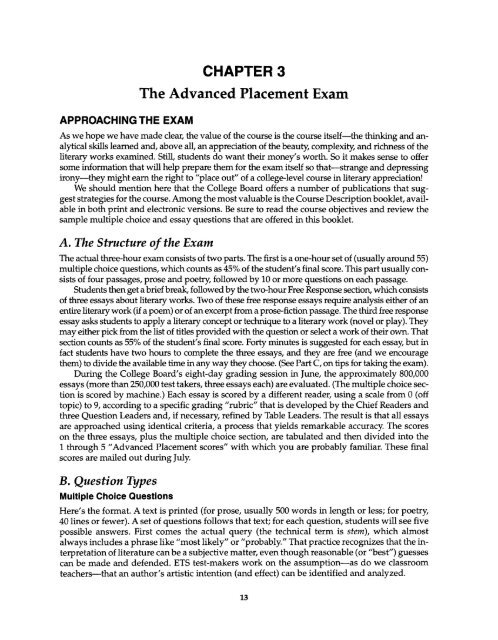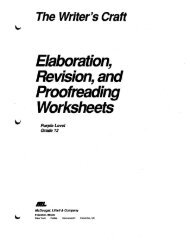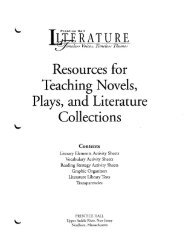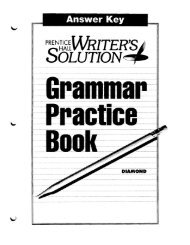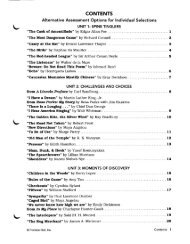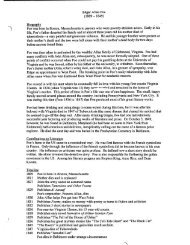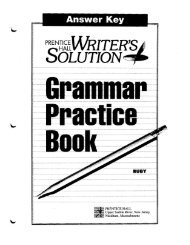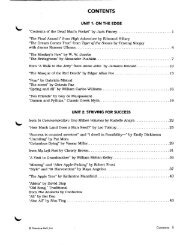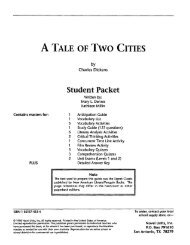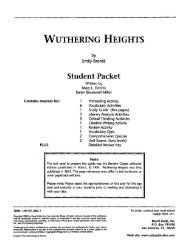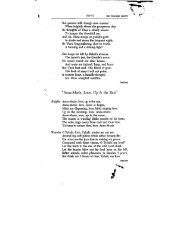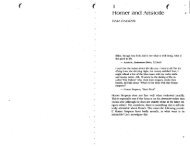English Literature & Composition - PopulationMe.com
English Literature & Composition - PopulationMe.com
English Literature & Composition - PopulationMe.com
You also want an ePaper? Increase the reach of your titles
YUMPU automatically turns print PDFs into web optimized ePapers that Google loves.
APPROACHING THE EXAM<br />
CHAPTER 3<br />
The Advanced Placement Exam<br />
As we hope we have made clear, the value of the course is the course itself-the thinking and analytical<br />
skills learned and, above all, an appreciation of the beauty, <strong>com</strong>plexity, and richness of the<br />
literary works examined. Still, students do want their money's worth. So it makes sense to offer<br />
some information that will help prepare them for the exam itself so that-strange and depressing<br />
irony-they might earn the right to "place out" of a college-level course in literary appreciation!<br />
We should mention here that the College Board offers a number of publications that suggest<br />
strategies for the course. Among the most valuable is the Course Description booklet, available<br />
in both print and electronic versions. Be sure to read the course objectives and review the<br />
sample multiple choice and essay questions that are offered in this booklet.<br />
A. The Structure of the Exam<br />
The actual three-hour exam consists of two parts. The first is a one-hour set of (usually around 55)<br />
multiple choice questions, which counts as 450/0 of the student's final score. This part usually consists<br />
of four passages, prose and poetry, followed by 10 or more questions on each passage.<br />
Students then get a brief break, followed by the two-hour Free Response section, which consists<br />
of three essays about literary works. Two of these free response essays require analysis either of an<br />
entire literary work (if a poem) or of an excerpt from a prose-fiction passage. The third free response<br />
essay asks students to apply a literary concept or technique to a literary work (novel or play). They<br />
may either pick from the list of titles provided with the question or select a work of their own. That<br />
section counts as 55% of the student's final score. Forty minutes is suggested for each essay, but in<br />
fact students have two hours to <strong>com</strong>plete the three essays, and they are free (and we encourage<br />
them) to divide the available time in any way they choose. (See Part C, on tips for taking the exam).<br />
During the College Board's eight-day grading session in June, the approximately 800,000<br />
essays (more than 250,000 test takers, three essays each) are evaluated. (The multiple choice section<br />
is scored by machine.) Each essay is scored by a different reader, using a scale from 0 (off<br />
topic) to 9, according to a specific grading "rubric" that is developed by the Chief Readers and<br />
three Question Leaders and, if necessary, refined by Table Leaders. The result is that all essays<br />
are approached using identical criteria, a process that yields remarkable accuracy. The scores<br />
on the three essays, plus the multiple choice section, are tabulated and then divided into the<br />
1 through 5 1/Advanced Placement scores" with which you are probably familiar. These final<br />
scores are mailed out during July.<br />
B. Question Types<br />
Multiple Choice Questions<br />
Here's the format. A text is printed (for prose, usually 500 words in length or less; for poetry,<br />
40 lines or fewer). A set of questions follows that text; for each question, students will see five<br />
possible answers. First <strong>com</strong>es the actual query (the technical term is stem), which almost<br />
always includes a phrase like "most likely" or "probably." That practice recognizes that the interpretation<br />
of literature can be a subjective matter, even though reasonable (or "best") guesses<br />
can be made and defended. ETS test-makers work on the assumption-as do we classroom<br />
teachers-that an author's artistic intention (and effect) can be identified and analyzed.<br />
13


